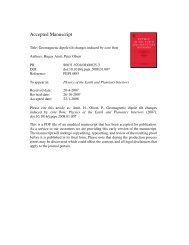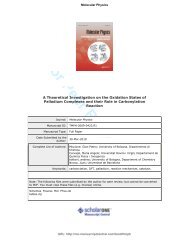WHAT IS THE BEST MEASURE OF EMPLOYMENT AND ... - TARA
WHAT IS THE BEST MEASURE OF EMPLOYMENT AND ... - TARA
WHAT IS THE BEST MEASURE OF EMPLOYMENT AND ... - TARA
Create successful ePaper yourself
Turn your PDF publications into a flip-book with our unique Google optimized e-Paper software.
sharing and so on These developments have increased the blurring of the<br />
boundaries between work and unemployment An additional complication has<br />
been the veritable explosion in recent years of a whole range of special State<br />
employment and training schemes where participants themselves may have<br />
genuine difficulties in deciding whether they are at work or unemployed<br />
Using data from the Labour Force Surveys (LFS) from 1983 to 1986 this paper<br />
examines the extent to which the traditional rigid distinction between work and<br />
unemployment may no longer hold Different measures of labour force<br />
aggregates and unemployment rates are presented and discussed, in this<br />
context the concept of underemployment is also considered The detailed<br />
analysis of the structure of unemployment identifies more clearly the<br />
population groups which might be targeted for special labour market<br />
measures<br />
As an official Statistician I must hastily point out that the question asked in the<br />
title of the paper is not meant to suggest that the currently published measures<br />
of employment/unemployment are in any way unreal or invalid The purpose is<br />
rather to alert users of the data to the fact that quite different measures can be<br />
obtained depending on the approach or concepts used The time may well be<br />
opportune to broaden our traditional approach to the measurement of<br />
employment and unemployment in Ireland I hope that the discussion and<br />
subsequent reaction to the paper will help us all to better understand the<br />
relative advantages and disadvantages of the various alternative measures<br />
which might be used to replace or complement the current statistics<br />
Labour Force Estimates - Historical Approach<br />
At the outset I think it is best to set the present measures of labour force<br />
aggregates in Ireland in their historical context Labour force estimates<br />
compiled up to the mid 1970's were based on the periodic stocktaking counts<br />
given by the Census of Population The estimates for intercensal and<br />
postcensal years were based on interpolations using the range of relevant<br />
indicators available at the time In general, the Census-based labour force<br />
estimates were derived from the respondents' statements of their "usual<br />
principal occupation" in conjunction with a description of the "employment<br />
status" and the name and nature of business of the employer<br />
Being just one of many topics to be covered in a Census, the number of<br />
questions devoted to establishing the labour force status is of necessity very<br />
limited Furthermore, since the Census questionnaire is designed for<br />
self-completion by the public the content and wording has to be relatively<br />
simple and easily understood by all sections of the population Thus<br />
complicated filtering procedures which are possible when trained interviewers<br />
are used, are totally out of place in the Census However, it is also probably<br />
fair to say that the labour market of even 10/15 years ago was considerably<br />
less complex than in recent years and, therefore, more capable of<br />
measurement by fairly simple questions<br />
186
















